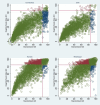Deciphering the Neighborhood Atlas Area Deprivation Index: the consequences of not standardizing
- PMID: 38756979
- PMCID: PMC10986280
- DOI: 10.1093/haschl/qxad063
Deciphering the Neighborhood Atlas Area Deprivation Index: the consequences of not standardizing
Abstract
The Area Deprivation Index (ADI) is a widely used measure recently selected for several federal payment models that adjusts payments based on where beneficiaries live. A recent debate in Health Affairs focuses on seemingly implausible ADI rankings in major cities and across New York. At the root of the issue is the importance of standardization of measures prior to calculating index scores. Neighborhood Atlas researchers are implicitly arguing that their choice to not standardize is of little consequence. Using the same data and methods as the Neighborhood Atlas, this paper focuses on this choice by calculating and comparing standardized and unstandardized ADI scores. The calculated unstandardized ADI nearly perfectly matches the Neighborhood Atlas ADI (r > 0.9999), whereas the correlation with a standardized version is much lower (r = 0.7245). The main finding is that, without standardization, the ADI is reducible to a weighted average of just 2 measures-income and home values-certainly not the advertised multidimensional measure. Federal programs that have incorporated the ADI risk poorly allocating scarce resources meant to reduce health inequities.
Keywords: area measures of deprivation; health inequity; payment reform.
© The Author(s) 2023. Published by Oxford University Press on behalf of Project HOPE - The People-To-People Health Foundation, Inc.
Conflict of interest statement
Please see ICMJE form(s) for author conflicts of interest. These have been provided as supplementary materials.
Figures


Similar articles
-
The Neighborhood Atlas Area Deprivation Index For Measuring Socioeconomic Status: An Overemphasis On Home Value.Health Aff (Millwood). 2023 May;42(5):702-709. doi: 10.1377/hlthaff.2022.01406. Health Aff (Millwood). 2023. PMID: 37126749
-
Association Between Community-Level Social Risk and Spending Among Medicare Beneficiaries: Implications for Social Risk Adjustment and Health Equity.JAMA Health Forum. 2023 Mar 3;4(3):e230266. doi: 10.1001/jamahealthforum.2023.0266. JAMA Health Forum. 2023. PMID: 37000433 Free PMC article.
-
Neighborhood socioeconomic disadvantages influence outcomes following rotator cuff repair in the non-Medicaid population.J Shoulder Elbow Surg. 2024 Jun;33(6S):S25-S30. doi: 10.1016/j.jse.2024.03.002. Epub 2024 Mar 20. J Shoulder Elbow Surg. 2024. PMID: 38518884
-
The Neighborhood Atlas Area Deprivation Index And Recommendations For Area-Based Deprivation Measures.Health Aff (Millwood). 2023 May;42(5):710-711. doi: 10.1377/hlthaff.2023.00282. Health Aff (Millwood). 2023. PMID: 37126740
-
Area Deprivation Index as a Surrogate of Resilience in Aging and Dementia.Front Psychol. 2022 Jun 29;13:930415. doi: 10.3389/fpsyg.2022.930415. eCollection 2022. Front Psychol. 2022. PMID: 35846636 Free PMC article. Review.
Cited by
-
Validating 8 Area-Based Measures of Social Risk for Predicting Health and Mortality.JAMA Health Forum. 2025 Aug 1;6(8):e252669. doi: 10.1001/jamahealthforum.2025.2669. JAMA Health Forum. 2025. PMID: 40815521 Free PMC article.
-
Comparing Deprivation vs Vulnerability Index Performance Using Medicare Beneficiary Surgical Outcomes.JAMA Surg. 2024 Dec 1;159(12):1404-1413. doi: 10.1001/jamasurg.2024.4195. JAMA Surg. 2024. PMID: 39356528
-
Comparative Analysis of Indices for Social Determinants of Health in Pediatric Surgical Populations.JAMA Netw Open. 2024 Dec 2;7(12):e2449672. doi: 10.1001/jamanetworkopen.2024.49672. JAMA Netw Open. 2024. PMID: 39656457 Free PMC article.
-
Effects of Air Pollution on Respiratory Events and Pain Crises among Children with Sickle Cell Disease in New York City.Ann Am Thorac Soc. 2024 Dec;21(12):1733-1741. doi: 10.1513/AnnalsATS.202310-860OC. Ann Am Thorac Soc. 2024. PMID: 39194342 Free PMC article.
-
Neighborhood Socioeconomic Disadvantage and Acute Care Utilization in Washington State Medicaid: A Retrospective Cohort Study.J Gen Intern Med. 2025 Feb;40(3):595-602. doi: 10.1007/s11606-024-09114-w. Epub 2024 Oct 11. J Gen Intern Med. 2025. PMID: 39394471
References
-
- Link BG, Phelan J. Social conditions as fundamental causes of disease. J Health Soc Behav. 1995:Spec No:80-94. - PubMed
-
- Adler NE, Newman K. Socioeconomic disparities in health: pathways and policies. Health Aff (Millwood). 2002;21(2):60–76. - PubMed
-
- Health Resources and Services Administration . Negotiated Rulemaking Committee on the Designation of Medically Underserved Populations and Health Professional Shortage Areas: Final Report to the Secretary. Health Resources and Services Administration; 2011. https://www.ruralhealthinfo.org/assets/3262-13308/nrmcfinalreport.pdf
-
- Office of the Assistant Secretary for Planning and Evaluation (ASPE) . Landscape of area-level deprivation measures and other approaches to account for social risk and social determinants of health in health care payments. 2022. Accessed July 29, 2023. https://aspe.hhs.gov/sites/default/files/documents/8dc674c904723bf8a5ce4...
-
- Phillips RL, Liaw W, Crampton P, et al. . How other countries use deprivation indices—and why the United States desperately needs one. Health Aff (Millwood). 2016;35(11):1991–1998. - PubMed
LinkOut - more resources
Full Text Sources
